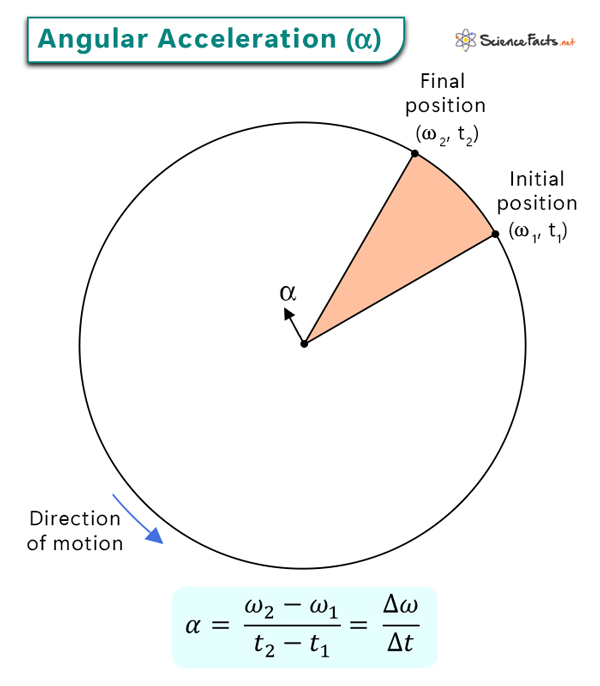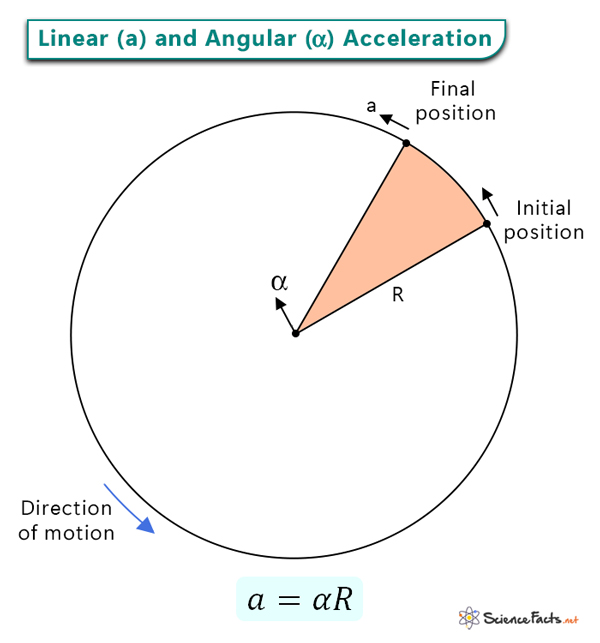Angular Acceleration
In rotational dynamics, angular or rotational acceleration is the time rate of change of angular velocity. It measures how quickly an object’s rotation speeds up or slows down. For instance, when a skater pushes her arms down, she rotates faster. When the driver slams a car’s brakes, the wheels slow down. Therefore, the skater and the wheels have angular acceleration.
Angular acceleration is a vector quantity. It has both magnitude and direction. It is analogous to linear acceleration in translational motion. Unlike linear acceleration, a force is not required for angular acceleration. The skater can accelerate her rotation by contracting her arms. Thus, no external torque is necessary.
Angular acceleration is fundamental in understanding rotational dynamics and is crucial in various scientific and engineering applications. Many objects in our daily lives exhibit rotational motion, such as spinning tops, wheels, and planets in orbit.
Formula
The Greek symbol alpha α represents angular acceleration. The average angular acceleration is given by the change in angular velocity (Δω) over the interval (Δt) during which the change occurs.
Where ω1 is the initial angular velocity at time t1, and ω2 is the final angular velocity at time t2. Positive angular acceleration implies an increase in angular velocity, while negative angular acceleration indicates a decrease. The angular velocity does not change for uniform circular motion, and the angular acceleration is zero. The direction of the angular acceleration vector is perpendicular to the plane where the rotation takes place.
Units and Dimensions
The SI unit of angular acceleration is radians per second squared or rad/s2. The dimensional formula is [M0 L0 T-2]. Also, 2π radian = 360°.
Instantaneous Angular Acceleration
The angular velocity of the object changes with time. Suppose we want to know the angular acceleration at a particular instant of time. The instantaneous angular acceleration is obtained by taking the limit of the average angular acceleration as the time diminishes, that is, Δt → 0. Mathematically, its magnitude is calculated by taking the time derivative of the angular velocity.
It can also be written as the double derivative of the angular displacement (θ) since ω = dθ/dt.
Relationship with Linear (Tangential) Acceleration
When an object rotates, it has both linear acceleration and angular acceleration. We want to find out the relationship between the two. The linear acceleration (a) is the rate at which the linear velocity (v) changes.
The relationship between the linear velocity and the angular velocity is
Where r is the radial distance of the point under consideration from the origin or the object’s radius. Therefore,
Therefore, linear acceleration is the product of the angular acceleration and the radius. Its direction is tangential to the point under consideration and is referred to as the tangential acceleration.
Since the linear acceleration and angular acceleration are directly proportional, the greater the angular acceleration, the larger the linear acceleration, and vice versa. The radius also matters. For instance, the smaller a car wheel, the smaller its linear acceleration for a given angular acceleration.
Relationship with Torque and Moment of Inertia
Angular acceleration is closely linked to the concept of torque, which is the rotational analog of force in linear motion. It is also related to the moment of inertia, which measures an object’s resistance to changes in its rotational motion. The moment of inertia depends on both the mass and the distribution of mass around the axis of rotation. According to Newton’s second law of motion for rotation, the net torque (τ) acting on an object is equal to the moment of inertia (I) times angular acceleration (α).
The above expression for angular acceleration does not involve time. Objects with high moments of inertia require more torque to achieve a given angular acceleration. For instance, a hollow sphere has a higher moment of inertia than a solid sphere of the same mass and radius. Therefore, rotating it will require more torque to achieve the same angular acceleration as the solid sphere.
Example Problems
Problem 1. If the angular velocity of a rotating object changes from 12 rad/s to 16 rad/sec in 1.2 sec, calculate the angular acceleration.
Given ω1 = 12 rad/s, ω2 = 16 rad/s, and Δt = 1.2 s
The angular acceleration is
α = (ω2 – ω1)/Δt
=> α = (16 rad/s – 12 rad/s)/1.2 s
=> α = 3.33 rad/s2
Problem 2. The front wheel of a motorcycle picks up an angular acceleration of 22 rad/s2 from 0 to 5 seconds. What is its angular velocity?
Given α = 22 rad/s2, ω1 = 0, and Δt = 5 s
The change in angular velocity is given by
Δω = αΔt
=> ω2 – 0 = 22 rad/s2 x 5 s
=> ω2 = 110 rad/s
-
References
Article was last reviewed on Friday, July 28, 2023









